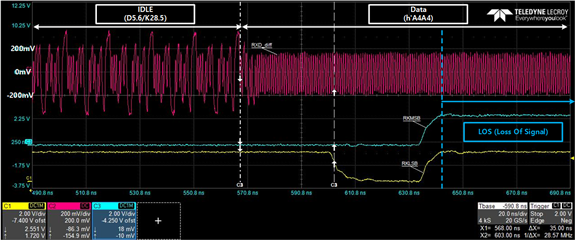Hi,
As I know, the LOS status output (RKxSB = High, RXD0-15 = High) when the incoming signal no longer has a sufficient voltage level.
But if you look at the waveform that I measured as below, RKxSB are high even though the RXP/N (Differential signal) is nearly 400mV and RXD15-0 are output h'FFFF.
That means that TLK2711-SP recognized the input data (h'A4A4) as LOS.
Strangely, this phenomenon occurs only in certain data patterns (h'A4A4, h'B5B5). It is all OK in other data patterns.
I did built-in self tests by combining PRBSEN with LOOPEN and it was OK . (RKLSB signal remained high.)
And I changed AC coupling capacitor value (10nF -> 1nF -> 100pF), but the result was same. (My setup configuration : TX FPGA (CML) -> TLK2711 (VML/AC Coupled)
Currently, I'm using 16EA TLK2711-SP device but only 2EA devices have this problem. I wonder if TLK2711-SP causes LOS when DC balanced valid input pattern is entered.

Best regards,

